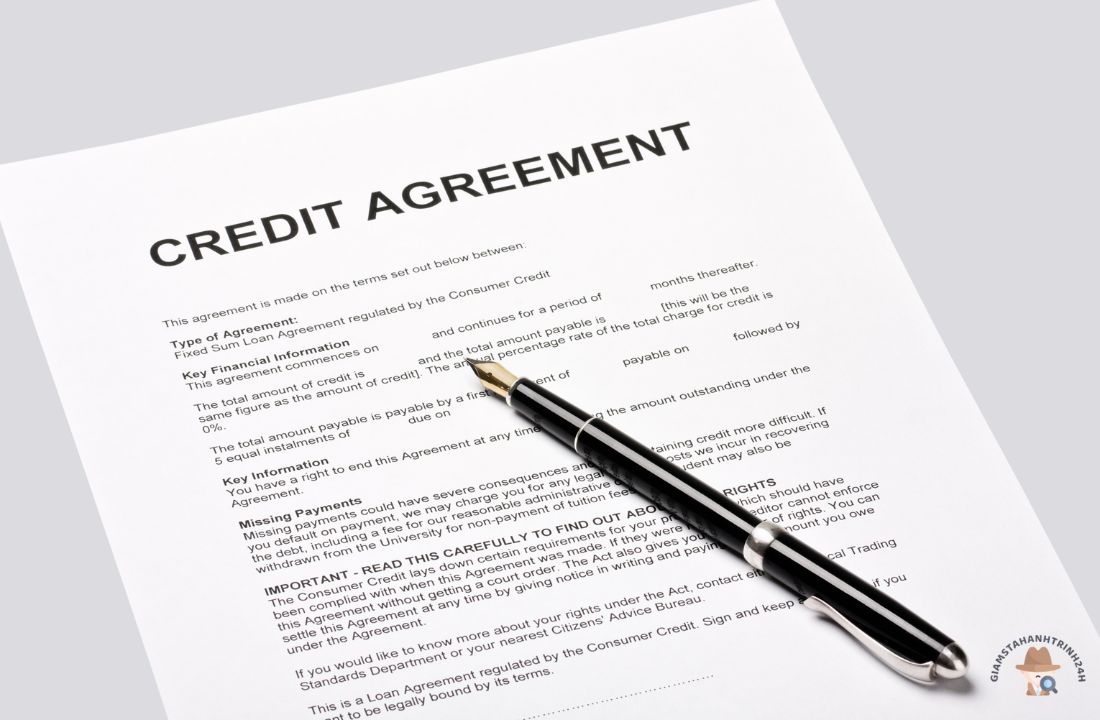A credit agreement is a legally binding contract between a lender and a borrower that outlines the terms and conditions of a loan. It specifies the amount of money borrowed, the interest rate, the repayment schedule, and the rights and obligations of both parties. Understanding the key elements of a credit agreement is crucial for both lenders and borrowers to protect their interests and ensure a smooth financial transaction. And now let’s find out with giamsathanhtrinh24h.vn.
Credit Agreement
A credit agreement is a document that sets out the terms and conditions of a loan between a lender and a borrower. It is a legally binding contract that outlines the rights and responsibilities of both parties. The purpose of a credit agreement is to provide clarity and transparency in a financial transaction and to protect the interests of both the lender and the borrower.

Types of Credit Agreements
There are various types of credit agreements, depending on the type of loan and the purpose of the loan. Some common types of credit agreements include:
- Personal loans: These are loans taken by individuals for personal use, such as home renovations, education, or debt consolidation.
- Business loans: These are loans taken by businesses for various purposes, such as expansion, working capital, or equipment purchase.
- Credit card agreements: These are agreements between a credit card issuer and a cardholder, outlining the terms and conditions of using the credit card.
- Mortgage agreements: These are agreements between a lender and a borrower for a home loan.
- Auto loan agreements: These are agreements between a lender and a borrower for a car loan.
Each type of credit agreement may have specific terms and conditions, but they all contain similar key elements.
Credit Analysis
Before entering into a credit agreement, lenders conduct a credit analysis to assess the creditworthiness of the borrower. This involves evaluating the borrower’s credit history, income, assets, and liabilities to determine their ability to repay the loan. The credit analysis helps lenders determine the interest rate, loan amount, and repayment terms for the borrower.

Factors Considered in Credit Analysis
Lenders consider various factors when conducting a credit analysis, including:
- Credit score: This is a numerical representation of a borrower’s creditworthiness based on their credit history. A higher credit score indicates a lower risk for the lender.
- Income: Lenders assess the borrower’s income to determine their ability to make loan payments.
- Debt-to-income ratio: This is the ratio of a borrower’s monthly debt payments to their monthly income. A lower debt-to-income ratio indicates a better ability to manage debt.
- Collateral: Some loans require collateral, such as a home or car, which can be seized by the lender if the borrower defaults on the loan.
- Employment history: Lenders may also consider the borrower’s employment history to determine their stability and ability to repay the loan.
Credit Approval
Once the credit analysis is complete, the lender will decide whether to approve the loan or not. If the loan is approved, the lender will provide the borrower with a credit agreement outlining the terms and conditions of the loan. The borrower must carefully review the credit agreement before signing it to ensure they understand all the terms and conditions.

Key Elements of a Credit Agreement
- Loan Amount and Term
The credit agreement clearly states the amount of money borrowed by the borrower. It also specifies the term of the loan, which is the period over which the loan must be repaid. The term can range from a few months to several years, depending on the purpose of the loan and the repayment capacity of the borrower.
- Interest Rate
The interest rate is the percentage charged by the lender for borrowing money. It is expressed as an annual percentage rate (APR). The interest rate can be fixed, variable, or a combination of both. Fixed interest rates remain constant throughout the loan term, while variable interest rates may fluctuate based on market conditions.
- Repayment Schedule
The repayment schedule outlines the dates and amounts of the loan payments. It specifies whether the payments will be made monthly, quarterly, or annually. The amount of each payment is determined by the loan amount, the interest rate, and the loan term.
- Fees and Charges
Credit agreements may also include fees and charges, such as origination fees, late payment fees, and prepayment penalties. These fees can significantly impact the overall cost of the loan, so borrowers must carefully review them before signing the agreement.
- Default and Remedies
The credit agreement should also outline the consequences of defaulting on the loan and the remedies available to the lender. This includes the right to seize collateral, charge late fees, or take legal action to recover the outstanding balance.
- Representations and Warranties
Both parties make certain representations and warranties in a credit agreement. Lenders may require borrowers to provide proof of income, assets, and other financial information. Borrowers may also have to represent that they are not involved in any legal proceedings or bankruptcies.
- Governing Law and Jurisdiction
Credit agreements also specify the governing law and jurisdiction for any disputes that may arise between the lender and the borrower. This ensures that both parties are subject to the same laws and regulations and provides clarity in case of any legal issues.
Credit Card
A credit card is a type of revolving credit that allows cardholders to borrow money up to a predetermined limit. The cardholder can use the credit card to make purchases or withdraw cash, and they must repay the borrowed amount along with any interest and fees charged by the issuer.

Credit Card Agreement
When a person applies for a credit card, they must sign a credit card agreement with the issuer. This agreement outlines the terms and conditions of using the credit card, including the interest rate, fees, and repayment terms. It also specifies the cardholder’s rights and responsibilities and the issuer’s rights and remedies in case of default.
Credit Score Check
Credit card issuers conduct a credit score check before approving a credit card application. This helps them assess the applicant’s creditworthiness and determine the credit limit and interest rate for the card. A higher credit score can result in a lower interest rate and a higher credit limit.
Credit Agreement Termination Notice
A credit agreement may be terminated by either party under certain circumstances. The lender may terminate the agreement if the borrower defaults on the loan or violates any of the terms and conditions. The borrower may also terminate the agreement by paying off the loan in full. In such cases, a credit agreement termination notice is required to inform the other party of the termination.

Contents of a Credit Agreement Termination Notice
A credit agreement termination notice should include the following information:
- The names and contact information of both parties
- The date of the termination
- The reason for the termination
- The outstanding balance, if any
- Any actions to be taken by either party after the termination, such as returning collateral or releasing liens
- Signatures of both parties
Conclusion
A credit agreement is a crucial document in any financial transaction involving borrowing money. It outlines the terms and conditions of the loan and protects the interests of both the lender and the borrower. By understanding the key elements of a credit agreement, borrowers can make informed decisions and ensure a smooth and successful financial transaction.
giamsathanhtrinh24h.vn

